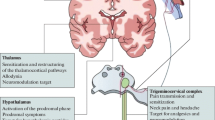Abstract
Migraine is a high prevalence disorder which affects a significant proportion of the general population, especially women during their central and more productive time of the life, thus causing severe disability. The genetic basis of the disease is unknown and the mechanism is poorly understood. The possibility that following a perturbation in the central nervous system, and particularly in the brainstem, trigeminal neurons become hyperexcitable and produce an uncontrolled release of sensory neuropeptides which eventually results in arterial vasodilatation and neuronal sensitization, has been gaining credit from studies in experimental animals and humans. In particular, experimental and clinical data with antagonists of the calcitonin gene-related peptide (CGRP) propose this molecule and its receptor as a major target for migraine treatment.
Access this chapter
Tax calculation will be finalised at checkout
Purchases are for personal use only
Similar content being viewed by others
References
(2004) The International Classification of Headache Disorders, 2nd edn. Cephalalgia 24:9–160
Lipton RB, Stewart WF, Diamond S, Diamond ML, Reed M (2001) Prevalence and burden of migraine in the United States: data from the American Migraine Study II. Headache 41:646–657
Burton WN, Conti DJ, Chen CY, Schultz AB, Edington DW (2002) The economic burden of lost productivity due to migraine headache: a specific worksite analysis. J Occup Environ Med 44:523–529
Ferrari MD (2008) Migraine genetics: a fascinating journey towards improved migraine therapy. Headache 48:697–700
Holzer P, Wachter C, Heinemann A, Jocic M, Lippe IT, Herbert MK (1995) Sensory nerves, nitric oxide and NANC vasodilatation. Arch Int Pharmacodyn Ther 329:67–79
Goadsby PJ (2005) Migraine pathophysiology. Headache 45:S14-S24
Geppetti P, Capone JG, Trevisani M, Nicoletti P, Zagli G, Tola MR (2005) CGRP and migraine: neurogenic inflammation revisited. J Headache Pain 6:61–70
Moskowitz MA, Macfarlane R (1993) Neurovascular and molecular mechanisms in migraine headaches. Cerebrovasc Brain Metab Rev 5:159–177
Saito K, Markowitz S, Moskowitz MA (1988) Ergot alkaloids block neurogenic extravasation in dura mater: proposed action in vascular headaches. Ann Neurol 24:732–737
Kurosawa M, Messlinger K, Pawlak M, Schmidt RF (1995) Increase of meningeal blood flow after electrical stimulation of rat dura mater encephali: mediation by calcitonin gene-related peptide. Br J Pharmacol 114:1397–1402
Gerrits RJ, Stein EA, Greene AS (1998) Laser-Doppler flowmetry utilizing a thinned skull cranial window preparation and automated stimulation. Brain Res Brain Res Protoc 3:14–21
Dux M, Santha P, Jancso G (2003) Capsaicin-sensitive neurogenic sensory vasodilatation in the dura mater of the rat. J Physiol 552:859–867
Petersen KA, Birk S, Doods H, Edvinsson L, Olesen J (2004) Inhibitory effect of BIBN4096BS on cephalic vasodilatation induced by CGRP or transcranial electrical stimulation in the rat. Br J Pharmacol 143:697–704
Leao AA (1986) Spreading depression. Funct Neurol 1:363–366
Dalsgaard-Nielsen T (1955) Migraine diagnostics with special reference to pharmacological tests. Int Arch Allergy Appl Immunol 7:312–322
Ahlner J, Andersson RG, Torfgard K, Axelsson KL (1991) Organic nitrate esters: clinical use and mechanisms of actions. Pharmacol Rev 43:351–423
Sicuteri F, Del Bene E, Poggioni M, Bonazzi A (1987) Unmasking latent dysnociception in healthy subjects. Headache 27:180–185
Iversen HK, Olesen J, Tfelt-Hansen P (1989) Intravenous nitroglycerin as an experimental model of vascular headache. Basic characteristics. Pain 38:17–24
Sances G, Tassorelli C, Pucci E, Ghiotto N, Sandrini G, Nappi G (2004) Reliability of the nitroglycerin provocative test in the diagnosis of neurovascular headaches. Cephalalgia 24:110–119
de Hoon JN, Pickkers P, Smits P, Struijker-Boudier HA, Van Bortel LM (2003) Calcitonin gene-related peptide: exploring its vasodilating mechanism of action in humans. Clin Pharmacol Ther 73:312–321
Jansen-Olesen I, Mortensen A, Edvinsson L (1996) Calcitonin gene-related peptide is released from capsaicin-sensitive nerve fibres and induces vasodilatation of human cerebral arteries concomitant with activation of adenylyl cyclase. Cephalalgia 16:310–316
Goadsby PJ, Edvinsson L, Ekman R (1990) Vasoactive peptide release in the extracerebral circulation of humans during migraine headache. Ann Neurol 28:183–187
Olesen J, Diener HC, Husstedt IW, Goadsby PJ, Hall D, Meier U, Pollentier S, Lesko LM (2004) Calcitonin gene-related peptide receptor antagonist BIBN 4096 BS for the acute treatment of migraine. N Engl J Med 350:1104–1110
Ho TW, Mannix LK, Fan X, Assaid C, Furtek C, Jones CJ, Lines CR, Rapoport AM (2008) Randomized controlled trial of an oral CGRP receptor antagonist, MK-0974, in acute treatment of migraine. Neurology 70:1304–1312
Frobert Y, Nevers MC, Amadesi S, Volland H, Brune P, Geppetti P, Grassi J, Creminon C (1999) A sensitive sandwich enzyme immunoassay for calcitonin gene-related peptide (CGRP): characterization and application. Peptides 20:275–284
Kraig RP, Cooper AJ (1987) Bicarbonate and ammonia changes in brain during spreading depression. Can J Physiol Pharmacol 65:1099–1104
Ayata C, Jin H, Kudo C, Dalkara T, Moskowitz MA (2006) Suppression of cortical spreading depression in migraine prophylaxis. Ann Neurol 59:652–661
Echlin FA (1950) Spreading depression of electrical activity in the cerebral cortex following local trauma and its possible role in concussion. Arch Neurol Psychiatry 63:830–832
Author information
Authors and Affiliations
Corresponding author
Editor information
Editors and Affiliations
Rights and permissions
Copyright information
© 2010 Springer Science+Business Media, LLC
About this protocol
Cite this protocol
Benemei, S., De Cesaris, F., Nicoletti, P., Materazzi, S., Nassini, R., Geppetti, P. (2010). Migraine Models. In: Szallasi, A. (eds) Analgesia. Methods in Molecular Biology, vol 617. Humana Press, Totowa, NJ. https://doi.org/10.1007/978-1-60327-323-7_9
Download citation
DOI: https://doi.org/10.1007/978-1-60327-323-7_9
Published:
Publisher Name: Humana Press, Totowa, NJ
Print ISBN: 978-1-60327-322-0
Online ISBN: 978-1-60327-323-7
eBook Packages: Springer Protocols




